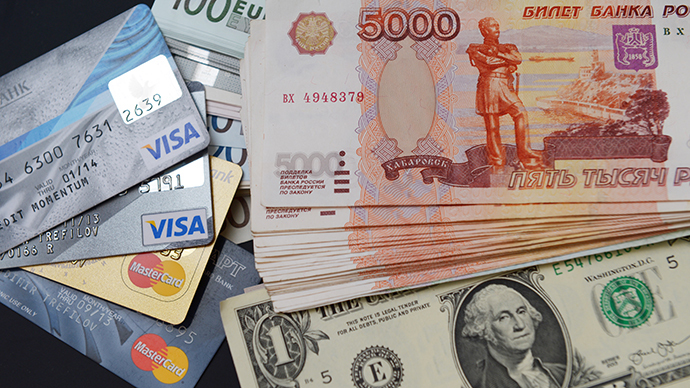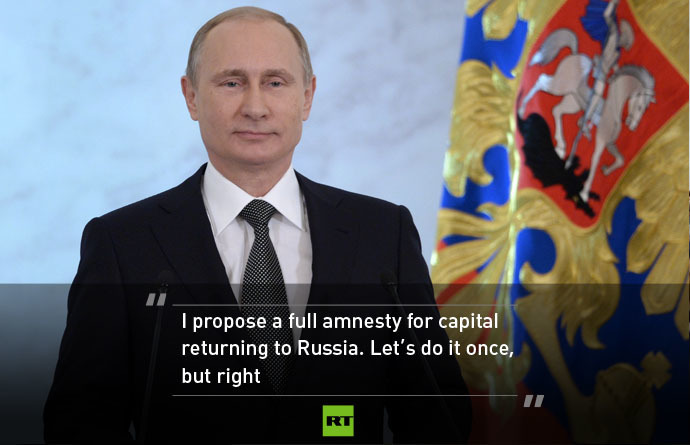Putin welcomes billionaires back to Russia – but will they come?

President Putin’s surprise amnesty allowing Russians with cash stashed abroad to bring it back home with no penalty may be a windfall, but then maybe not. The US, Mexico, Italy, Kazakhstan, and many others have tried it with varied success.
When financial crises hit, governments have tried to reel in assets held overseas by both companies and individuals, and sweeten the deal to convince them to bring the money home.
READ MORE: Putin offers amnesty for money coming back to Russia
“The experience of these tax amnesties, or capital amnesties, are that there are a lot of people that would like to bring their money back in the right way so it is not be in danger of being seized, and then use it to invest in the domestic economy,” Ben Aris, Editor of Business New Europe, told RT.
Switzerland
The country was the first to implement an “economic amnesty” program in the post-war period in Europe. Switzerland amnestied bank deposits and capital belonging to Germany’s wartime generation. This was done to strengthen the banking system in Switzerland. However, not all Germans got their money back-thousands still have pre-war cash in Switzerland, Luxembourg, Lichtenstein, or Austria that they can’t access without paying fines of up to 50 percent.
Italy
More than €80 billion was returned as a result of the 2009 tax amnesty initiative. Prior to the tax evasion amnesty, the Bank of Italy estimated that Italian citizens had €500 billion in undeclared funds outside the country. Rome has offered dozens of tax amnesty opportunities since the 1980s.
"Full amnesty for capital flight is a measure that is frequently introduced by countries that have suffered capital flight problems. For instance, Italy used to have a lot of problems and from time to time used to announce tax amnesties," said Gabriel Stein, Director of asset management services of Oxford Economics.
Ireland
Another example of a successful amnesty program was Ireland in 1998. The program lasted 10 months and raised $1.5 billion for the treasury.
Russia

As Russia's economy is slowing down, the president announced a plan to bring money back to the motherland by offering a tax amnesty program that won’t penalize Russians for bringing it home.
Russia has tried its hand at tax amnesty before. In 2007 the policy collected $130 million in the first six months. Participation was limited to those who had never been convicted of tax evasion or other tax related crimes.
“The real question is, what sort of opportunities do Russians that have this money overseas, see in Russia? And whether they want to bring it back and make use of it within the country?” Aris said. According to Ben Aris, capital flight in Russia has been rampant since the collapse of the Soviet Union.
Oxford Economics asset manager Gabriel Stein isn’t so convinced the money will come flowing back.
Russia’s rich will “worry that whatever is promised in the amnesty may be reversed later,” said Stein, who believes that the impact of Russia’s amnesty offer will be “limited.”
“There is an enormous pool of [Russian, Ed] money overseas,” Aris said, adding the country is “probably looking at hundreds of million, if not billions of dollars, maybe more.”
The Russian Economy Ministry suggests 2014 will top capital flight records, estimating that $125 billion will have left the country in the course of the year, more than double that of 2013. The highest annual record is 2008, when $133.6 billion left the country. Between 2008-2013, $418 billion exited. That means Russia, which is the only emerging economy that doesn’t restrict movement of capital, has lost more than $500 billion in the last seven years. However, not all of this is Russian money; much is foreign investment pulling out.

USA
The US ran a voluntary disclosure program after the financial crisis. Since 2009, US financial regulators have already reeled in $6.5 billion in unpaid tax and penalties. Forty-five thousand Americans voluntarily disclosed their offshore holdings.
Those who didn’t make the deadline now have to pay. The US Foreign Account Tax Compliance Act, or FATCA, is a new law that makes it more difficult for individuals to hide money abroad, as institutions are obliged to report on foreign clients. It came into force July 1, 2014 after being signed into law in 2010 and applies to any American or American company with a foreign bank account with more than $50,000.
Within the US, there are many states that utilize tax amnesty programs at a micro level. Louisiana has been called tax amnesty capital of the US by its own governor.
Argentina
In 1995, $3.9 billion was returned, and the government didn’t prosecute people involved in criminal tax evasion. It ran its first amnesty program in 1987.
India
In 1997, India ran an aggressive tax amnesty campaign that brought in $2.5 billion using the slogan “30 percent taxes, 100 percent peace of mind,” and had 350,000 participants.

Kazakhstan
“Other countries that have gone down this road, like Kazakhstan, and they always bring in large amounts of money. The key question is exactly how much money it will bring,” Aris said.
In the early 2000s, Kazakhstan managed to repatriate about $480 million in capital, according to bank officials. The tax regulator also granted each and every citizen a “clean slate” erasing all income tax records for the previous 5 years.
Mexico
In 2012, Mexican tax authorities set up a tax amnesty program for both individuals and businesses to return money, either by full or partial waver. Full amnesty was granted to those who didn’t pay taxes between 2007 and 2012, and an 80 percent reduction was offered to omit taxes before 2007. All amnesty requests were due by May 31, 2013, and the government hasn’t reported on the success on the program.
Spain, Portugal, Greece
Each country held tax amnesty programs following their respective bailout.
After the bailout left the country in financial ruin in 2010 the Greek government tried to use a tax amnesty to raise revenue, offering nationals major tax breaks on outstanding debts. A year later, the EU wound down the program on the grounds it didn’t meet the rules of the EU treaties.
Germany, Belgium
Both launched tax amnesty programs in 2004. The German monetary tool, aimed at recovering billions of euro hidden in neighboring Switzerland, raised over €80 billion to put in the treasury, and Belgium adopted a law that waved individuals’ undeclared income taxes held before 2004.
South Africa
In 2003, South Africa launched a tax amnesty program that eventually yielded nearly $8 billion. South Africa first applied tax amnesty as a part of the country’s transition in the early 1990s, under the Truth and Reconciliation Act.
Australia
Australia launched tax amnesties in 2007 and 2009 to crackdown on Australian money kept in tax havens, which tax authorities believe total more than $1 billion. In June 2010, individuals had voluntarily disclosed A$301.7 million.












